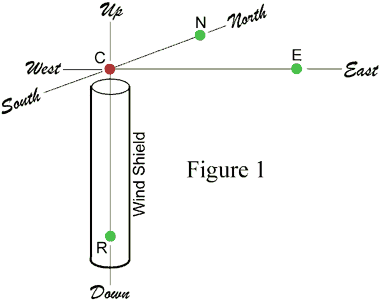A discussion of determining wind speed and direction by measuring differences in the atmospheric speed of sound. This approach differs from most sonic anemometers in that it uses a "no wind" speed of sound reference to nullify the effects of temperature, humidity and pressure.
Implementation:
 Sound impulse source at C
Sound impulse source at C
Sound pickup sensors at N, E & R
DN = distance C to N
DE = distance C to E
DR = distance C to R (windless ref)
D = DN = DE = DR
TN = time for sound to cross DN
TE = time for sound to cross DE
TR = time for sound to cross DR
(windless ref)
Speed = distance / time
Wind Speed = (Speed of Sound w/ Wind) - (Speed of Sound w/o Wind)
SN = North··South component of Wind
Speed
SE = East··West component of Wind Speed
SN = (D / TN)
- (D / TR)
SE = (D / TE) - (D / TR)
Wind Speed along Bearing = (SN^2 + SE^2)^˝
Bearing = arctan (SE / SN)
Notes:
- Using Speed of Sound w/o Wind (DR / TR) as a reference nullifies the effects of temperature, humidity, pressure and elevation on the wind speed calculations. The windless path (C-R) must be open to the atmosphere so that its temperature, humidity and pressure are ambient, but it must be protected from all winds (especially vertical).
- It is only necessary to know the precise distance between the sound impulse source and one pickup sensor. DR would probably be the easiest, both mechanically and computationally. The times to transit distance D for the other two sensors could then be calibrated when wind speed is zero.
- The maximum sample rate is a function of the speed of sound divided by the distance D. For D in meters, it is approximately 340 / D at sea level. For D = 1 meter the maximum sample rate is about 340 samples per second.
- This approach can be easily expanded to include vertical wind.
- Sensors N & E should hang below their support arms so that perching birds do not interfere with the sound paths.
- The wind shield for the reference path (DR) could be designed as a solar shield to house a temperature and pressure sensor. Since temperature and pressure can be measured easily and accurately, they and the reference Speed of Sound w/o Wind (DR / TR) can be used to compute humidity.
Considerations:
- The following should be explored to determine if the magnitude of their effects will require computational adjustments:
- temperature expansion/contraction of the support structure causing changes in the distance between the sound source and sensors (D).
- precipitation on the speed of sound.
- The frequency and power of the sound source must be high enough to prevent falsing and/or interference by environmental noise.
- The lowest sound source frequency is in part determined by the distance from the sound source to the pickup sensors (D) and the highest wind speed to be measured. It is claimed that bats use multiple frequencies up to 150KHz, thus establishing the probable lowest frequency limit for the sound source.
Pros:
- No moving parts, except high reliability sound transducers.
- High accuracy.
- Simple calibration.
- With proper design, measurements are not affected by frozen precipitation.
Cons:
- Support arms for the N & E sensors may have susceptibility to wind, ice and bird damage.
- Possible susceptibility to noise interference in high noise environments.
Background:
- I first developed this concept in the late 1980's, when building my first weather station. I was day dreaming about how to measure wind speed accurately and with minimal calibration difficulties. This method occurred to me because, time, and to a lesser degree, distance, can be easily measured accurately.
20040117